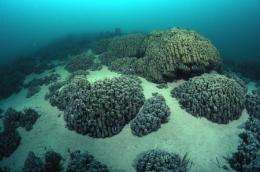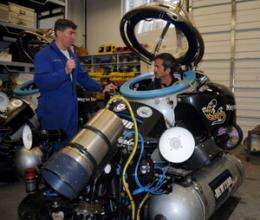Probing Pavilion Lake

A team of scientists and astronauts return this week to Pavilion Lake in the Canadian province of British Columbia. The scientists will be continuing their effort to understand what role biology plays in forming the strange structures that line the lakebed, while the astronauts will be learning how to do field science.
“For all intents and purposes,” says Allyson Brady of the University of Calgary, Pavilion Lake, in British Columbia, “seems to be a pretty normal lake. There are fish in it; people have cottages around the lake, you can go swimming.” It’s a lovely place to bring the family for a summer vacation.
But Brady, acting principal investigator of the Pavilion Lake Research Project (PLRP), and her colleagues won’t be vacationing this week when they descend into the depths of the lake, as they have for the past several summers. Despite its pastoral surface appearance, Pavilion Lake is anything but normal. Carpeting the slopes of the lakebed is an underwater forest of carbonate structures that, at first glance, might be mistaken for coral. These carbonate formations - PLRP’s researchers call them “microbialites” - range in size from small nodules the width of a quarter to massive mounds several meters across. Until they were discovered in Pavilion Lake, such formations were relatively unknown in freshwater lakes.
Similar structures are known to exist in a handful of other places in the world, in Shark Bay, Australia, for example, “but these tend to be more extreme environments,” Brady says. “Areas where you don’t find much else living there but bacteria,” because it’s too salty, too acidic or generally too extreme for other life forms to survive. No-one has been able to figure out yet what they’re doing in Pavilion Lake.
The central question is what role biology has played in forming the microbialites. “We’re trying to figure out if we can identify, basically, abiotic versus biotic processes,” Brady says. The structures are covered with a layer of living bacteria, and there is evidence that these bacteria may be influencing carbonate precipitation as a byproduct of their metabolism. So it’s possible, indeed it’s the leading theory, that Pavilion Lake bacteria are actively building the microbialite structures, and have been doing so for thousands of years. But it’s also possible that some not-yet-understood process of chemical precipitation is at work: no biology required. Or even that bacteria are the active builders at present, but may not have played that role in the past.
The microbialites come in a wide variety of shapes as well as sizes, including some that are similar in appearance to giant artichokes and cauliflower. Some have chimneys rising out of their midst. Their morphology, or shape, “seems to vary with the depth, but this isn’t something that we’ve 100 percent proven and are working to identify trends throughout the lake,” says Brady. “Something that we’re going to try to explore is the relationship between the microbial communities and light levels.” If carbonate precipitation, influenced by photosynthetic bacteria, “is a main mechanism for forming the microbialites, then changes in the light levels could be part of the reason why we see the different morphologies” at different depths.

Understanding the mechanics of what is going on in Pavilion Lake will help scientists make progress toward solving a broader problem, one central to astrobiology: identifying biosignatures. “A biosignature is an unambiguous signal of past life,” says Brady. “If we can find biosignatures in these modern environments… where you can sample the living bacteria, you can sample the water chemistry, we can measure the light levels… and can do analyses to your heart’s content, we might be able to apply that to either the geologic rock record,” that is, signs of ancient life in terrestrial rocks billions of years old, “or potentially to astrobiological environments as well,” that is, signs of ancient life in martian rocks billions of years old.
Biosignature work is complicated by the fact that chemical signals that may make it possible to identify present-day biological activity can degrade over time. In the case of Pavilion Lake, even if scientists can clearly show that modern bacteria are responsible for creating carbonate structures on the surface of the microbialites, “once the biology is gone,” that is, deeper within the microbialites or in older structures, “the carbonate could dissolve and re-precipitate, and if that happens any sort of biological chemical signature might get wiped away,” Brady says.
Researchers also plan this year to take a closer look at “grazers”: worms, snails and other small organisms that in most freshwater lakes consume bacteria at such a prodigious rate that the bacteria never get a chance to form any large-scale structures. “At Pavilion, there are grazers, but we wonder if they’re actually having a significant impact on the microbialites…. We are planning some night-time investigations of the microbialites and looking to see if grazing activity, which we haven’t really noticed in the daytime, actually increases at night.”
A pair of DeepWorkers, submersible vehicles, each large enough for a single person to squeeze inside, will play a pivotal role in these investigations. For the past two years, researchers have used the DeepWorkers to conduct a comprehensive survey of the lake and its microbialite structures. This year, Brady says, the DeepWorker activity will focus on studying particular areas in greater detail, spending “a couple of hours going up and down a [single] slope,” taking “the time to do really detailed imaging.”
And while they’re busy helping to unlock the mystery of Pavilion Lake’s microbialites, the DeepWorkers will be involved in another task as well: training astronauts to do good science. As they have in the past two years, astronauts from both NASA and the Canadian Space Agency (CSA) will take part in this year’s PLRP activities, including piloting the DeepWorker subs.
Astronauts are superbly well trained in the mechanics of space flight and procedures required for survival in space, Brady says. But, she adds, “The question really comes down to: if you were an astronaut and you were on Mars,” trying to find evidence of life, “would you know what to look for, how to explore and adapt to in-field situations?”
As part of its ongoing activity, PLRP has “developed an astronaut training program where the astronauts come up… and they do everything: they get an introduction to the history of the lake, the questions that frame the research that goes on at the lake… they help us with the [DeepWorker] flight planning, they drive the submersibles, they help with the data processing.” They’re “fully integrated into a real active field site” to help them develop the tools needed to become effective field scientists.
Source: Astrobio.net
















